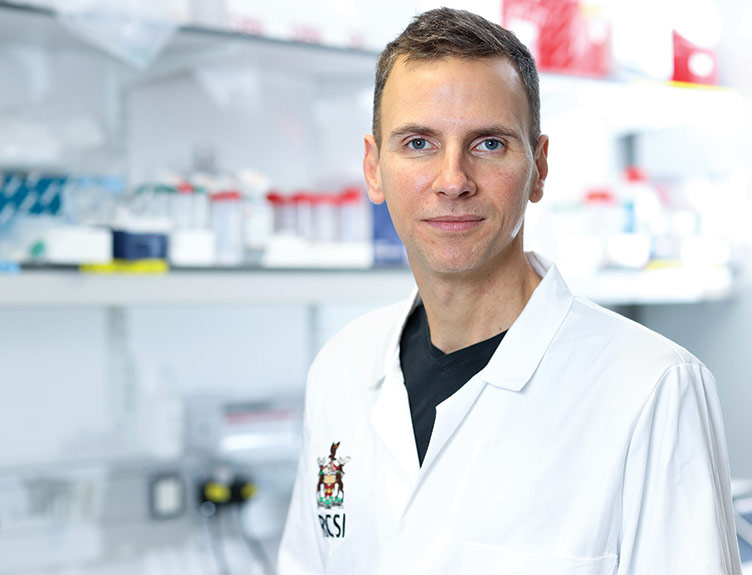AMBER researchers develop new material capable of regenerating diseased heart tissue

Researchers from AMBER, the Science Foundation Ireland-funded materials science institute, have developed a new biomaterial which is capable of both regenerating tissues which respond to electrical stimuli (such as the nerves, spinal cord, heart, brain and muscles) as well as eliminating infection - an ever-growing problem in hospitals. This could enable enhanced recovery for heart attack and burn patients.
The new study is published in Advanced Materials, a leading international materials science journal. The study was led by AMBER researchers at RCSI in partnership with Trinity College Dublin and Eberhard Karls University in Germany.
This new material could help to improve quality of life for heart attack survivors, as scar tissue build-up can decrease heart function. An electroconductive biomaterial could bypass damaged regions of the heart and restore functional activity.
For people with extensive nerve damage, there are currently very limited options in terms of repairing nerve injuries extending beyond two centimetres. However, by combining a biomaterial with proven regenerative capacity, like collagen, with a material that can carry an electrical stimulus, it may be possible to transmit electrical signals across damaged tissue, resulting in functional restoration of the affected area. This concept may also have potential in regenerative capabilities of the spinal cord and other areas including the brain.
The new material developed by the multidisciplinary research team is composed of collagen (the most abundant protein of the human body which has known regenerative potential and can support the body's cells) and graphene (the world's thinnest material which is known to have unique mechanical and electrical properties) resulting in an electroconductive ‘biohybrid' combining the beneficial properties of both materials - resulting in a material which is mechanically stronger, with increased electrical conductivity.
This ‘biohybrid' material has been shown to enhance cell growth and, when electrical stimulation is applied, directs cardiac cells to respond and align in the direction of the electrical impulse. Furthermore, the material prevents bacterial attachment, a hugely favourable characteristic which can be applied in the development of next generation antimicrobial medical devices. The surface roughness of the material, induced by the introduction of graphene, causes bacterial walls to be burst while simultaneously allowing the heart cells to multiply and grow.
Professor Fergal O'Brien, Head of the Tissue Engineering Research Group (TERG) in the Department of Anatomy in RCSI, Deputy Director of AMBER and lead Investigator on the project said: "Many cells and tissues in the body are responsive to electrical stimulation but electroconductive materials are limited because they may kill cells or cause infection. Despite progress in biomaterials science for some applications, there has been limited success in treating tissues of the heart and nervous system. There are currently no solutions for very large nerve defects and large areas of heart wall damage.
"We are very excited by the potential of this material for cardiac applications but the capacity of the material to deliver physiological electrical stimuli while limiting infection suggests it might have potential in a number of other indications such as repairing damaged peripheral nerves or perhaps even spinal cord. The technology also has potential applications where external devices such as biosensors and devices might interface with the body.
"This type of collaborative research is only possible in a centre like AMBER where leading researchers from different disciplines get to share ideas and work in partnership together."
Professor Jonathan Coleman, Principal Investigator in AMBER and Trinity's School of Physics said: ‘'It is remarkable to work with my AMBER colleagues in RCSI, combining bioengineering and physics to find a new application for the graphene being produced in our labs. Recently our team have pioneered the development of a technique to produce large quantities of pristine graphene at low cost and so it is significant that we are in a position to now create this new biomaterial using this wonder material."
The work was conducted by AMBER and RCSI TERG post-doctoral researcher, Dr Alan Ryan, first author on the paper with Dr Cathal Kearney, an AMBER senior research fellow and lecturer in RCSI in partnership with multi-disciplinary team of researchers based in RCSI, Trinity and Professor Katja Schenke-Layland's laboratory in Eberhard Karls University Tübingen in Germany, where the electrical stimulation research was carried out.
Professor Michael Morris, Director of AMBER, said: "Today's announcement about this new biomaterial demonstrates our track record of pushing the boundaries of science to discover real solutions for people. We will continue to carry out excellent research that has real societal impact, with this technology potentially improving the lives of thousands of people."



